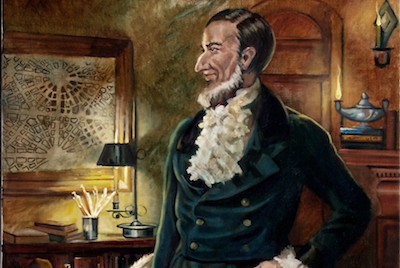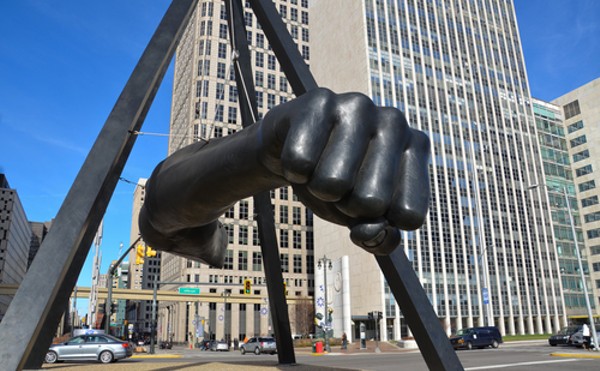The Detroit that never was: How the Woodward Plan died 197 years ago
[
{
"name": "GPT - Leaderboard - Inline - Content",
"component": "35519556",
"insertPoint": "5th",
"startingPoint": "3",
"requiredCountToDisplay": "3",
"maxInsertions": 100
}
]
As astute Detroit historians know, we're coming up on the anniversary of the day Detroit burned to the ground in 1805. That's right: On June 11, we mark 210 years since a conflagration swept through our little frontier burg, destroying the fort, barracks, and village, leaving 300 households homeless.
But there is a lesser-known anniversary we mark today: the final obliteration of a city that might have been. It was 197 years ago today that the so-called “Woodward Plan” for Detroit was abandoned once and for all.
The story begins in January of 1805, six months before the Great Fire of Detroit, in Washington, D.C., (itself a newly minted city being built under the fanciful design of Pierre Charles L'Enfant, with broad, diagonal avenues slicing through its rectangular city blocks). It was then and there that the federal government appointed 31-year-old Augustus Brevoort Woodward as a judge of Michigan Territory.
Woodward arrived in Detroit less than a month after the fire, the citizens in readiness to begin rebuilding the village. Woodward persuaded them to hold off, however, so officials could consider the best way to proceed. In the end, Woodward became in charge of laying out a new city, and few could have imagined a plan more fantastic than the one he finally arrived at, a system of dividing land into triangles, allotting each landowner just as much land as he'd owned before, but under the new configuration.
Woodward traveled to Washington that winter to obtain approval of the plan, then returned to Detroit to lay out an improved version of it over the summer of 1806. Surveyors worked out the plan on the ground into the fall, perfecting it.
In his book The Making of Urban America: A History of City Planning in the United States, John William Reps called Woodward's design “one of the most unusual city plans ever devised.” The law said, “... the bases of the town of Detroit shall be an equilateral triangle, having each side of the length of four thousand feet, and having every angle bisected by a perpendicular line upon the opposite side.”
The complicated plan involved a repeating hexagonal shape to contain smaller triangles, divided by broad thoroughfares that would continue through the city, with a “Grand Circus” at every major intersection, and smaller spaces reserved for public purposes. The scheme was also novel in that it had roads of different widths. The thoroughfares coursing through the city would be 200 feet wide lined with elliptical groves; secondary roads would be 120 feet wide and lined with trees; minor streets were still a generous 60 feet across. The slimmest streets were deep in the interior sections, where the noise of the city would find it hard to intrude. The plan even allowed for alleys.
It was an amazing plan, one to create a city more organized than Washington, D.C., more beautiful than Paris, to provide for a vigorous commerce but to have secluded nooks and accessible gathering spaces. Most who examine the plan must conclude that Woodward was a marvelously gifted urban planner.
As a politician, however, he was not as well endowed. The plan, of course, took more than a year to be drawn up, approved, and officially sanctioned. During all that time, the residents of the city were grumbling more loudly by the month, without clear title to land to build on, and increasingly distrustful of Woodward.
Although some parts of the city were laid out according to the judge's plan, as the years wore on, the dissatisfaction of residents eager for growth and the maneuvering of Woodward's peers continually threatened the plan's fate. In the 1810s, as more immigrants began trickling into the city, mounting opposition to extending the plan over 10,000 acres crested. The legislative board was asked to sell land in rectangular allotments. Woodward jockeyed judicially, introducing resolutions that no future deviations would be made.
But in the fall of 1817, while Woodward was away in Washington, D.C., Judge James Witherell talked Territorial Governor Lewis Cass and Judge John Griffin into starting up the sale of right-angled 160-acre farms in the 10,000-acre tract north of the city. The sales were scheduled to begin 197 years ago, on June 1.
On that day, Woodward blasted the scheme as illegal, and restated the importance of city planning in a rapidly developing country. The complaint, submitted in writing, stated: “Nature had destined the city of Detroit to be a great interior emporium, equal, if not superior, to any other on the surface of the … globe. … In such a case that art of man should aid the benevolence of the Creator, and no restricted attachment to the present day or to present interests should induce a permanent sacrifice of ulterior and brilliant prospects.”
The complaint was in vain. Land sales were begun in sections with right angles, and the opportunity to create the city Woodward envisioned was permanently gone.
Looking back on that date almost two centuries later, we might look at Woodward's plan a bit more fondly than Detroiters of that day. In some places downtown, the plan can be physically appreciated. The broad thoroughfare of Woodward still has half of his Grand Circus, and it was quickly girdled by skyscrapers by the 1920s, many of which still stand today. Campus Martius, which 20 years ago was mostly concerned with routing traffic through downtown, has been reclaimed as a public space, and is now very lively. In the narrow, interior streets Woodward's plan allowed, you can still catch a bit of the intimacy amid a hectic city, as in Harmonie Park (or “Paradise Valley,” or whatever it's called this week), where a small park provides lush greenery as the buildings enfold the people strolling down the sidewalk.
In the absence of a plan to tame Detroit's growth, the city retained its old obstacles and grew by accretion. The old “ribbon farms” were independently developed, leaving streets off-beam along many avenues. Streets would disappear like underground streams, only to bubble up a few blocks later. The city ended up lacking crosstown thoroughfares; at great expense in both money and architectural heritage, they had to be hacked through later. Other thoroughfares had to be widened through a kind of urban angioplasty, including Michigan and Woodward avenues, which once both narrowed to 66 feet across. And, even today, a visitor to Detroit must wonder, walking up Woodward, why the same street is on one side Henry, on the other Winder, then up on the left, Sibley, then on the right, not aligned, Adelaide, then on the left, Sproat, but several lots later, on the right, Alfred. And that it continues like this.
During his term more than a century ago, Mayor William C. Maybury was fond of saying that the city of Detroit was laid out on the plan of Washington, D.C. This repeated remark brought a vitriolic editorial in one of the Detroit newspapers, complaining that the city was not laid out in any sensible manner, and that any thoughtful person would regard the red line marking the city's borders on a map as the boundaries of a lunatic asylum. It's a complaint that rings true today.
Indeed, from the year 2015, we might well wonder what Detroit would look like today if Woodward's plan hadn't been abandoned. Would the order have tamed the city's growth, or made it more desirable? Would it have prevented boom-time Detroit from plopping down vast factories surrounded by grids of bungalows? Wouldn't Detroit have had a built-in profusion of public parks and amenities? Could an overarching plan have prevented the divisions between the city and its suburbs? Would residents have been less likely to flee the city when every neighborhood was so carefully planned? Or might Detroit have been a model for other cities, a honeycomb pattern as an alternative to the waffle-iron grid most American cities adopted?
Ultimately, Woodward's defeat established its own pattern, one we live by to this day: In the contest between intelligent plans and the demand for growth and profit, the latter wins. The orders of the industrialist, the desires of the developer, the impatience of the land speculator, have always prevailed over any finer sensibility in this town. Like the Detroiters of Woodward's time, when the forces of money and power win the day, we often hail it as a victory for all, if only because it means we know the way forward at last, however flawed or impermanent it is. But as long as we keep sacrificing brilliant prospects, however difficult they are to envision, in the name of what Woodward called an “attachment to … present interests,” we can expect a city checkered with failure.
At least, at one time, somebody thought we deserved better than that. That's worth remembering.






